YOUR CHOICE OF LIGHTING in the house may have minor to serious health ramifications over a long period of time. Artificial lighting emits different levels of harmful radiations. These include EMF radiation (electric fields, magnetic fields, dirty electricity), UV radiation, and blue light. Choice of lighting therefore depends on determining which type of light produces the least harm.
Components of light and whether they are beneficial or harmful
Light has different components. Only a small portion of the light is visible to us as shown in the “visible spectrum” section below, while most of it is not visible. Some of these light components are beneficial and others are harmful.
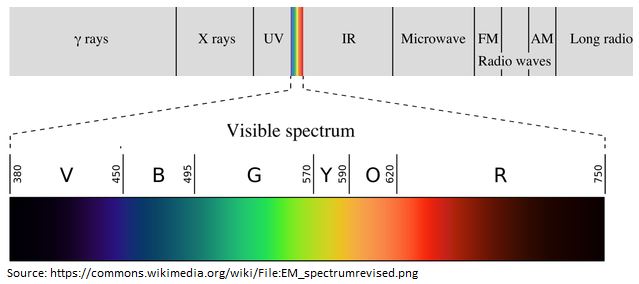
From right to left, frequency increases and wavelength decreases. Infrared light (IR) is followed by visible light (red, orange, yellow, green, blue, violet, which is followed by ultra-violet (UV) light.
Infrared light (IR)
- We cannot see infrared light but we feel it as heat.
- It is generally considered safe when it does not exceed the levels found in the sunlight.
- It penetrates our skin.
- There are two types if IR light: near infrared and far infrared. Both provide health benefits, including supporting the mitochondria, boosting energy production, reducing pain and inflammation, and stimulating the immune system.
- It also supports the protective mechanism against UV damage.
Red and Green light
- They promote skin health. Red light also supports the functioning of the mitochondria.
Blue light
- Blue light penetrates all the way to the back of the retina and damages the retina and the eye tissues. Excessive exposure to blue light is a known risk factor for developing cataracts and cancer.
- Blue light also suppresses melatonin production, which is essential for us to sleep and rest. Night-time exposure to blue light, therefore, is harmful as it affects the body’s ability to sleep. Melatonin suppression, however, is desirable during day-time. From that perspective, blue light is equally important during day time.
- In addition to certain light bulbs, digital screens are another significant source of blue light. These include TVs, computers, and mobile devices. Therefore, exposure to these screens after the evening is harmful for your health.
- You can find out how much blue light a lightbulb emits by looking at the “Lighting Facts” on the bulb package. Generally, the higher the CCT (Correlated color temperature), the greater the blue component (Cool light). CCT is the same as the “K” number shown on the bulb package. For night time, you want the least amount of K.
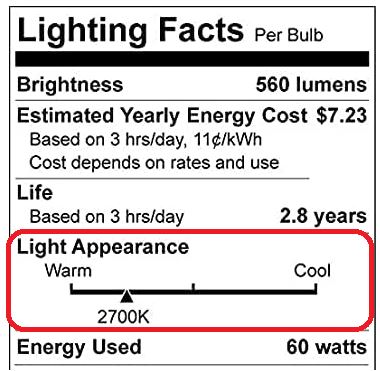
Ultra-violet Light (UV)
- Ultra-violet light is considered harmful. They can cause oxidative stress in our eyes, and skin and cell damage.
- Most artificial lights generate small to large amounts of UV radiation.
Critical role of melatonin
- Melatonin helps us to fall asleep and achieve deep sleep.
- Melatonin plays a critical role in preventing disease. It is also a powerful antioxidant.
- As dusk occurs and lights fade, the brain begins to produce melatonin to prepare the body for sleep. However, artificial light at night disrupts the melatonin production and makes it harder to fall asleep.
- Health issues that have been linked to melatonin suppression include various forms of cancer (especially breast, prostate, colorectal, endometrial, and skin), diabetes, metabolic syndrome, and obesity, cardiovascular disease, cognitive impairment, premature aging, insomnia, eye degeneration, gastrointestinal and digestive issues, infertility and poor pregnancy outcomes, autism, neurodegenerative diseases (Parkinson’s, Alzheimer’s), and mood and psychiatric disorders (seasonal affective disorder, depression, bipolar). (Read Dr. Nicholas Gonzalez’s interview on how blue light affects melatonin).
Other concerns with light bulbs
In addition to different components of light, artificial light bulbs may have other concerns, such as flickering, toxicity, and EMF radiations.
Flickering
- Some energy efficient lights bulbs flicker. They turn on and off to conserve energy and this happens at a fast rate. It is not usually perceived since the flickering happens rapidly.
- This flickering damages the eye. Even if we do not perceive the flickering, it is still being picked up by the eyes.
Toxic chemicals
- Some bulbs contain highly toxic chemicals, such as mercury, lead, arsenic, and heavy metals.
- They must be disposed off properly to avoid harming the environment.
- If these bulbs break, they pose great danger to health, including neuro-toxicity.
EMF Radiations
- All bulbs produce some amount of EMF radiations, including electric fields, magnetic fields, and dirty electricity. However, some are worse than others.
Below are the common light bulbs that are available in the market and their associated health risks.
Fluorescent and CFL Lights
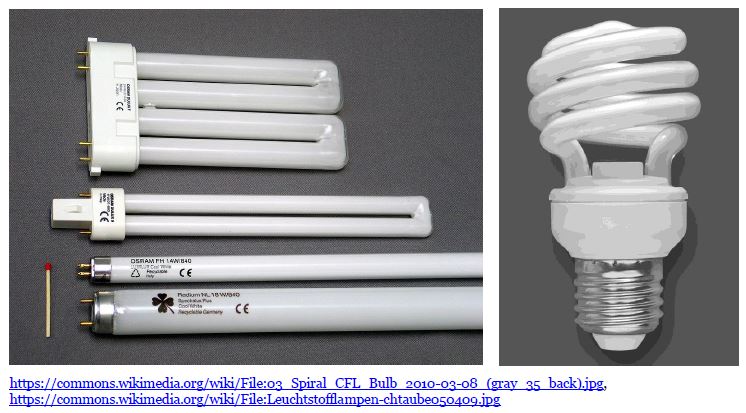
- These bulbs use current to excite a gas to illumination.
- The gas used is mercury, which is very toxic.
- They use electronic ballast to regulate the flow of electricity, converting the current into DC and then back into high-frequency AC (typically between 10kHz to 40kHz). The process creates spikes of dirty electricity.
- If it uses magnetic ballast, that creates high levels of magnetic fields.
- CFL light bulbs are among the worst in producing UV radiation, which is carcinogenic.
- Gives off blue light.
- Produce RF radiation.
- Flickering is a major concern with these bulbs.
- Although they are very energy efficient, these light bulbs are not recommended and should be avoided.
LED Lights
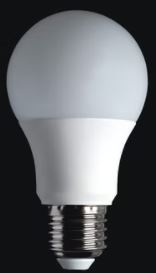
- LED light bulbs changes the frequency of AC current to DC current, which produces dirty electricity. But they do not require a ballast.
- They may back feed small amounts of electricity into the power line.
- LEDs are very energy efficient but they emit significant amounts of blue light. If you must have them, look for those that are coated for “warmer” light for night-time exposure.
- LEDs pose an elevated risk for eye toxicity.
- May contain lead, arsenic and other toxins.
- Some LEDs flicker, though not always perceived.
- No UV radiation.
- Very little magnetic fields.
- No mercury content but have other hazardous chemicals.
- LED technology continues to improve. Before using a certain brand and model of LED light, it should be tested for EMF and dirty electricity levels.
Halogen Lights
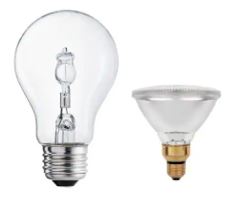
- Halogen bulbs use of the same technology as incandescent bulbs to produce artificial light, but use different materials and gases to make the process more efficient. They do not require a ballast.
- Instead of argon gas in incandescent light bulbs, they use halogen gas (usually iodine or bromine).
- There are two types: high-voltage (110 or 120 volts) and low-voltage (6 to 75 volts).
- Low-voltage ones requires a transformer (built-in or external) to “step-down” the voltage. That can produce high levels of magnetic fields and dirty electricity.
- High wattage halogen lamps can generate extremely high temperatures that can create a significant fire hazard.
- They emits large amounts of UV radiation, which is harmful for the eyes and can cause headache.
- They also produces high levels of blue light. Look for those that are coated for “warmer” light for night time exposure.
- They produces a lot of heat, thus can be dangerous to touch. So it’s important to keep flammable materials away from them.
- Avoid touching halogen bulbs with bare hands as the oil from the skin can reduce the life of the bulb.
Incandescent Lights
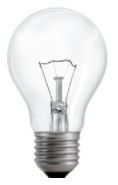
- These are the old-fashioned bulbs that work by conducting current through a thin filament and have no ballast.
- Produces a more natural hue of light, not a blue tinted light.
- They have no RF radiation
- Produce very little UV and EMF radiations – mostly as heat, which is least harmful.
- They have no dirty electricity as they do not alter the frequency of the power.
- Produce warmer light, which has little effect on melatonin suppression unlike what blue light does.
- They are very low in blue light, have no toxins, and have no flicker.
- Incandescent lamps emit up to 95% of their energy as infrared.
- These light bulbs are not energy efficient. However, from health standpoint, they are the safest light bulbs.
- Clear incandescent bulb is preferable.
Sunlight
- Sunlight has infrared light. Although “invisible,” the retina can perceive it.
- Sunlight obviously has visible light. This includes blue light, which is poorly blocked by the eye’s pigmentation. Blue light is good for health during daytime only.
- Sunlight has two types of UV lights: 1) UVA: Long wave ultra violet. It penetrates deep into the skin and 2) UVB: Short wave ultra violet. Part of vitamin D production process. The amount of vitamin D we produce depends on how much UVB radiation our skin is exposed to.
- Too much UV can result in skin and eye damage and increase the risk of certain skin cancers.
- UVB stimulates the production of the pigment melanin by our skin cells, which offers a protective function against excessive UV.
- Although we have long known that excessive sunlight can cause skin cancers, we are now finding out that sunlight also plays a key role in preventing cancers, diabetes, high blood pressure, heart disease, MS, osteoporosis, and psoriasis. Sunlight also plays an important tole in body’s ability to produce vitamin D.
- Sunlight received through windows is not a replacement for sunlight received outdoor. UVB light which produces vitamin D in our skin does not pass through glass.
Conclusions and Recommendations
- At daytime, obtain blue-rich bright light by spending time outside without wearing sunglasses.
- Reduce your exposure to light after dusk, especially two hours before bedtime.
- At night, avoid “cool” bright white lights, and use blue-depleted warm lights.
- Avoid screen-time at night (TV, computer, phone, etc.), especially two hours before bedtime. Use blue filters if you must use screens.
- For proper sleep and rest, keep bedrooms as dark as possible with no lights within the room. If a light source is needed, use red light. Use blackout curtains to block any light from outside.
- Avoid dimmers – they produce high levels of dirty electricity.
- Avoid light bulbs that have ballast/transformer.
- Your smart phone or digital device may include blue-blocking software. Activate it and set it to turn on in the evening.
- Wear blue-blocking glass at night.
- Cover computer screen with blue light filter or use software to do the same.
I am a certified Building Biologist and Electromagnetic Radiation Specialist. I conduct EMF and other environmental assessments at homes and offices. I also test light bulbs for EMF and dirty electricity levels. I can be reached at mr@yoursafeliving.com.

